The novels
Here are all of the graphical novels created by André Franquin, including the early and late stuff that falls outside of what I deem to be his golden age. It is presented chronologically.
The top italic descriptions were copied and adapted from Wikipedia.
Fantasio and his Tank (Fantasio et le tank), 1946
Fantasio buys a demobilized tank from an American soldier, and accidentally destroys the neighborhood with it. Spirou and the neighborhood boys help with repairs.
This is the very first “test” story Franquin drew to convince Jijé of his abilities. He was 22 years at the time and would continue with the series for another 22 years.
The Prefabricated Houses (Les Maisons préfabriquées), 1946
Fantasio becomes a salesman of seaside prefabricated houses. It was begun by Jijé, but he later handed it over for Franquin to finish it off.
The Inheritance of Spirou (L’Héritage), 1946
Spirou inherits from a deceased uncle, a strange house with secrets.
This is the earliest of his stories that I’ve read. In the beginning, Franquin uses a very rigid framework of equally sized frames. It makes the pages feel quite archaic.
Spirou is accompanied by Spip and Fantasio as part of the set of characters Franquin had to work with when he took over. Fantasio is quite tall and smokes a pipe. In the later novels, he tends to lose a bit of his height but he still remains marginally taller than Spirou.
There’s a lot of action and gags – animated cartoons may have influenced it a lot.
The Mad Genius (Le Savant fou), 1947
Spirou joins Fantasio on a journalistic trip. They see a car with no driver causing panic in town. Following this invention, they meet an insane scientist who has built a robot with the goal to destroy the world.
The evil Professor Samovar sometimes feel like a spiritual predecessor to Zorglub – some 13 years before that character is finally conceived.
The robot in this novel is strong, fast and ominous. In some pages it’s even reminiscent of the much later Terminator movies.
Spirou and the Robot’s Plans (Les plans du robot), 1948
Spirou and Fantasio need to protect the world from criminals getting their hands on mad Professor Samovar’s blueprints for a robot with doomsday potential.
This is the sequel to the previous story with Professor Samovar.
Two situations, one on page 11 and one on page 16, look like they were inspired by similar situations in Tintin novels.
Spirou in the Ring (Spirou sur le ring), 1948
Poildur, a neighbor bully, challenges Spirou to a boxing match, who nobly accepts and asks Fantasio to coach him. An entire Brussels working class community turns out for the big event, and an epic boxing match of courage against cheating tactics is played out.
There’s a lot of training in this story.
Spirou Rides a Horse (Spirou fait du cheval), 1949
Fantasio attempts to mix it up with the upper class by playing the equestrian dandy gentleman, and Spirou reluctantly joins him to go horseback riding. Fantasio is given a very noble steed named Artaban, while Spirou’s horse, Plumeau, is ridiculously unhorse-like.
Fantasio acts like a very distinguished gentleman. The horse Spirou rides is very playful and some of the gags in the story feels like they belong in a Donald Duck story.
Spirou meets the Pygmees (Spirou chez les Pygmées), 1949
A leopard escapes from the zoo and manages to become friendly with Spirou and Fantasio. They take it home to an African island, leading to adventures with pygmy tribes and arms-dealing villains.
The leopard and Spirou together gives vibes about the Marsupilami that would eventually be introduced about two years later.
Fantasio is seen in extremely colorful fashion clothes. The story also contains more dialog than usual. At one point, black pygmy tribe members are washed to reveal them as brown, thereby settling a dispute with another tribe of that color.
The Black Hats (Les chapeaux noirs), 1950
Spirou and Fantasio travels to USA, on assignment to report on the status of Wild West. Upon arrival they are disappointed to find a modern culture, but by chance meet a man who directs them to Tombstone, a town with all the western myths intact.
The framework is changed and now consists of four strips per page.
One fight between Spirou and a brute bears quite a resemblance to a similar fight in one of the earlier Lucky Luke novels.
Mystery at the Frontier (Mystère à la frontière), 1950
Our heroes investigate a case hoping to expose a smuggling ring responsible for bringing into Belgium a new drug called “Hicoine”.
Another story with Tintin vibes.
There is a Sorcerer in Champignac (Il y a un sorcier à Champignac), 1951
Spirou and Fantasio end up near the village of Champignac. They meet its pompous mayor and rustic inhabitants, and an aloof local landowner, the Count of Champignac. He manages to create a temporary potion that endows superhuman strength, which a gangster later steals to create mayhem.
This marks the end of the short story period and also the beginning of what I consider the golden age of Franquin’s Spirou. It’s also the first time we see the Champignac, its mayor, and of course the first meeting with the Count of Champignac.
The first full story is a whopping 57 pages and also tweaks the framework again. The Count looks a bit like a Sherlock Holmes clone in this introduction. Fantasio is used as a guinea pig testing a potion that gives superhuman strength for a short while. The Count then uses it to win various branches of sports.
Spirou and the Heirs (Spirou et les héritiers), 1952
Fantasio needs to compete against his cousin Zantafio to inherit from a long-absent uncle. The deceased has devised three trials for the two men: creating an original and useful invention, achieving a top 6 Grand Prix race position, and finally capturing a mysterious animal, the Marsupilami in the Palombian jungle.
Introduces Fantasio’s unsympathetic cousin Zantafio and the marvelous Marsupilami. Right from the beginning the animal is seen performing a lot of the cool tail stunts he is known to repeat throughout the golden age of the series.
The contemporary 50’s style makes its first appearance. Fantasio invents his “Fantacopter” – a small mini-helicopter that can be worn as a backpack.
The Marsupilami Robbers (Les voleurs du Marsupilami), 1952
Spirou and Fantasio regret giving the Marsupilami to a zoo, and decide to free the animal again and return it to its original home. This plan fails because someone else beats them to the abduction. This brings them to the fiendish Circus Zabaglione.
The Marsupilami is sedated and stolen from the zoo, then brought to the circus. Our duo acts under cover in the circus, using a potion from the Count of Champignac to change Fantasio’s skin color on the fly.
The Rhinoceros Horn (La corne de rhinocéros), 1953
Spirou and Fantasio rescue the race car driver Roulebille who has been wounded by murderous thugs. Roulebille’s employers, Turbot, have designed a car so spectacular that competitors will stop at nothing to steal its revolutionary plans. They reluctantly team up with another journalist, a young woman called Seccotine. The search for Martin takes them to Africa where they look for the missing blueprints from the titular body part.
The Marsupilami is sadly not present in this story.
The “Fantacopter” is used again in the beginning. Seccotine is introduced, and at the end of the story, Spirou and Fantasio are gifted with the keys to a new Turbot car.
The Dictator and the Mushroom (Le dictateur et le champignon), 1953
Our heroes decide to take the Marsupilami back to his home in the Palombian jungles. They discover that Fantasio’s shady cousin Zantafio has reinvented himself as General Zantas and become the country’s ruthless dictator. The now power-mad Zantafio is intent on invading a neighboring country.
The Count of Champignac introduces the awesome pink spray “Métomol” that completely softens metal. This is used to melt most of Zantafio’s military hardware. Seccotine is also seen on page 41 and helps our duo bring Zantafio down.
The Wrong Head (La mauvaise tête), 1954
Due to a few missing passport photos, Fantasio finds himself a victim of a conspiracy to frame him as the thief of an invaluable Egyptian gold mask. Appearing completely guilty, he is forced to flee from the law, attempting escape from the city disguised as a competing bicyclist in a mountain endurance race, leaving Spirou alone with the tough task of exposing the real villains and clearing Fantasio’s name.
The second story where the Marsupilami is sadly not present.
This story is almost like a thriller, with Fantasio escaping miscarriage of justice and Spirou investigating by himself. There are several intense action events, in particular one with Spirou enduring a nasty fall that almost kills him.
This is regarded as one of the best novels, in spite of the absence of Marsupilami.
The Moray’s Hideout (Le repaire de la murène), 1955
A shipping magnate offers a prize to the makers of a submarine innovation in order to find his sunken ship off the French Mediterranean coast. The Count of Champignac’s mini-sub invention is so spectacular that the competition must resort to sabotage. A chain of secrets need to be exposed while the maritime criminal John “the Moray” Helena lurks in the deep.
The Count invents X4, a mushroom decoction that multiplies the brain power by ten. He uses this to figure out how to create the diving vessel, including a new oxygen system for scuba divers. The diving vessel actually looks quite feasible.
The Marsupilami turns out to be an amphibian, i.e. it can also breath underwater.
Pirates of Silence (Les pirates du silence), 1956
Fantasio gets an assignment to write a story about Incognito City, a highly modernized city inhabited by wealthy celebrities and where security is tight and photography forbidden. Further encounters with thugs and suspicious events slowly expose a fiendish plot, involving the kidnapping of the Count of Champignac.
Our heroes discover that the Marsupilami can also repeat human words, much like a parrot.
A sedative gas is used in the city much like in Goldfinger, the James Bond movie that would eventually be released 6 years later.
Gorilla’s in Good Shape (Le gorille a bonne mine), 1956
Spirou and Fantasio journey to central Africa on a journalistic expedition to seek out the rare gorillas of Mount Kilimaki. Their efforts become increasingly difficult, justifying the suspicion that someone tries to prevent the reporters from reaching their goal.
Spirou and Fantasio uses a Citroën 2CV to get to Africa. The goal is to photograph the gorillas in their natural habitat. Fantasio even uses a gorilla suit to get closer to them.
The Marsupilamis’ Nest (Le nid des Marsupilamis), 1957
Seccotine invites Spirou and Fantasio to a screening of her new documentary film, revealing what she has been doing since she was last seen in Palombia. The film follows a Marsupilami in the wild as he discovers and courts a mate, and they form a family in need of care and protection.
Probably the most interesting Marsupilami novel of them all. Lots of great ideas as well as many interesting details about them are revealed.
Seccotine narrates the documentary from a desk next to the large screen.
The Traveler from the Mesozoic (Le voyageur du Mésozoïque), 1957
The Count of Champignac sensationally returns from an Antarctic expedition with an intact dinosaur egg believed to be from the Jurassic period. Back in Champignac, the Count’s closest professor friends arrive and proceed to plan ways to hatch the egg. Soon the village of Champignac has a big dinosaur problem on its hands.
Fantasio acquires a nasty cold and misses out on almost the entire story. He is present, but he’s constantly blowing his nose and doesn’t sense anything around him.
There’s a lot of Marsupilami action in this novel.
Uneventful Holidays (Vacances sans histoires), 1957
The heroes take a road-trip south to the French riviera. This leads to an encounter with an abundantly wealthy sheikh and allegedly the worst car driver in the world, and who mistakenly tries out their Turbot-Rhino.
The original blue Turbot-Rhino car is totally wrecked by the sheikh, but he buys them a modern blue/white Turbot car with new great design ideas.
Gaston Lagaffe is seen on a bike, and Seccotine on a scooter. Fantasio drives a bizarre veteran car with a lot of “James Bond”-style features.
Gangsters at the Fair (La foire aux gangsters), 1958
Spirou and Fantasio are unexpectedly assaulted by a small martial arts expert, Soto Kiki, who wants to train them in judo in order to act as bodyguards for the European visit of oil tycoon John P. Nut, a man with gangster enemies. All changes as the gangsters attempt to assassinate Soto Kiki, and kidnap the millionaire’s infant son.
Spirou and Fantasio is introduced to judo by a kung fu master. First, their asses are handed to them as sort of a demonstration (until the Marsupilami kicks his ass) and later they take lessons to learn the art and use it against boxers later in the story.
Sadly, the judo they learn is contained to this story and not used in the subsequent novels. Yes, the good old “reset button” at work.
Again, Gaston Lagaffe is seen in a few frames.
Tembo Tabou, 1958
Spirou and Fantasio find themselves on another expedition traveling upstream an African river, in search of a vanished American author. Events become increasingly more strange when they discover red elephants, befriend a pygmy tribe, learn of Marsupilami’s love of eating warrior ants, and confront a gang of “protection racket” thugs who cultivate meat-eating plants.
The Prisoner of the Buddha (Le prisonnier du Bouddha), 1958
A Russian scientist, Nicolas Inovskyev, the co-inventor of a revolutionary and powerful device named the G.A.G., is in hiding in Champignac fearing the same fate as his American partner Harold W. Longplaying. Longplaying has been kidnapped by the Chinese army and is being held captive in one of a series of giant statues of the Buddha which line up a valley. Armed with the new invention, the heroes set out to rescue the prisoner.
This is the novel with a gadget that looks conspicuously like the gravity gun used more than 40 years later in the video game Half-Life 2. Here called the GAG (even the abbreviation is almost a match) it can also lift and push people, which the video game counterpart can only do in the final hour or so.
I’ve written a blog post about this subject, in case you’re interested in reading more about it.
Spirou and the Bubble Men (Spirou et les hommes-bulles), 1959
John Helena escapes from captivity, and Spirou, Fantasio and the Count suspect he is going after the gold that is still in a ship wreckage. A sudden trend of mini-submarine sabotage prompts the heroes to investigate.
This is a continuation of The Moray’s Hideout (see above).
The Count’s amazing yellow diving vessels are also used again in this story.
Fear at the End of the Line (La peur au bout du fil), 1959
The Count continues to develop concoctions from mushrooms, but in a thoughtless moment he mistakes the toxic X4 residue from his cup of coffee, causing him to undergo big changes. His usually benevolent personality is inversed into pure evil, and our heroes must act to protect the village from this new, unlikely terrorist.
The Small Formats (Les petits formats), 1959
Marsupilami playfully exposes Fantasio’s unused film, forcing him to go to a photo store to buy replacements. When Spirou next meets Fantasio, he has been reduced to a palm-sized, paralyzed miniature statue, which causes Spirou to question his own sanity.
As Spirou finds the amazingly detailed miniature statue of Fantasio, the novel turns into sort of a detective story almost solely from Spirou’s point of view.
Fantasio is later seen walking around with an altered state of mind, acting like an animal.
Z is for Zorglub (Z comme Zorglub), 1959
Zorglub, an old acquaintance of the Count of Champignac, appears from the past and offers the Count the chance to join him in seizing world domination, but it is firmly rejected. In response, Zorglub proceeds to demonstrate his powers by manipulating the township of Champignac to storm the Count’s mansion, which nearly leads to the destruction of his laboratory. As this just barely fails, Zorglub decides to kidnap Fantasio.
This is the first story with the megalomaniacal arch-villain Zorglub. Fantasio is hypnotized and leaves in a car driven by a seemingly invisible man. Spirou is next in line.
Zorglub meets the Count and wants him to cooperate with him, but The Count drinks his strength potion and then throws him out. Later, the Count also invents the first version of a deflector that bypasses the zorglonde, a weapon that Zorglub uses to stun people.
One of the most intense parts of the novel is when Fantasio is zapped and kidnapped by Zorglub, then run through a brain-washing facility to turn him into one of his minions.
The ending is a bit far-fetched, even for this series. The Count gives Zorglub permission to create a visual presentation that involves a ton of rockets going for the moon.
The Shadow of Z (L’ombre du Z), 1960
Our heroes find the population of Champignac have been paralyzed by a minion of Zorglub they left behind sedated, who awoke and went on a stunning spree. After the ordeal of pacifying the rogue minion and restoring the people of Champignac to normal, time passes until Zorglub’s sinister schemes again become evident. Without remorse, Zorglub continues to work for world domination from Palombia.
The second story with Zorglub is a direct continuation of the previous novel. Our heroes arrive back at the village of Champignac to see everyone stunned. The Count figures out how to awaken them using a heavy jumble of electronic devices and a lot of wires.
In Palombia, Zorglub uses a hypnotizing sound to lure everyone into buying his products, but as Zorglub later learns of the downside, he actually regret his actions.
Zantafio uses his position in Zorglub’s army to rob a bank.
In the end of the story, Zantafio uses a powerful energy rifle to zap Zorglub by accident. The repercussions of this can be seen in Babysitting in Champignac (see below).
QRN over Bretzelburg (QRN sur Bretzelburg), 1961-63
Trouble stems from Fantasio’s amazingly small transistor radio which gets wedged stuck inside the Marsupilami’s nose. The device jams the transmissions received by Marcelin Switch, a neighbor and radio enthusiast, who claims that this puts the life of King Ladislas of Bretzelburg in grave danger. Fantasio is abducted by the secret Bretzelpolizei who mistake him for Switch. Spirou, Spip and the nervous Switch then travels to the dictatorial state of Bretzelburg, determined to rescue Fantasio.
I consider this to be the last novel in the golden age of Franquin’s take on Spirou.
That being said, the novel is top quality and contains a lot of great ideas. The tiny radio getting stuck in the nose of the Marsupilami, the torturer creating revolting sounds with a piece of chalk on a blackboard (then breaking his nail on it), the bus with pedals instead of an engine, the torturer turning to cooking, the guard that can both shout and whistle at the same time – the story truly is a cornucopia of hilarious gags.
Hurray for the Brothers (Bravo les Brothers), 1966
This story takes a small step back in time to illustrate the hectic working conditions at Dupuis publishing house prior to Spirou and Fantasio’s much needed vacation. The influence of Gaston in the pursuit of having De Mesmaeker sign contracts is a well-explored theme in Gaston albums, but in this instance, there is the added element of “Les Brothers”, a circus act of performing chimpanzees that Gaston gifts Fantasio for his birthday.
This feels like a Gaston Lagaffe story, even though Spirou is generally in the center of it.
Franquin’s different drawing style also permeates the novel. It’s more intricate and detailed, but it also doesn’t really fit Spirou and Fantasio anymore.
Babysitting in Champignac (Panade à Champignac), 1968
Spirou and Fantasio, the latter stressed by the pressures of work and the aggravating presence of Gaston Lagaffe, take a break at the estate of Champignac. Upon arrival, they learn that the Count’s life has changed dramatically since the conclusion of the last Zorglub story. He now spends his time taking care of Zorglub who has regressed to the mental age of 8 months. To make things worse, one of Zorglub’s minions has not been healed and lurks nearby, armed with a zorglonde and obsessed with liberating his former leader.
The last long story with Spirou and Fantasio from Franquin. Again, the new drawing style and the condensed type of gag humor dominates the story, adding up to a completely different feel than the novels of the golden age.
There are even Gaston Lagaffe gags in the beginning, until our duo leaves the city.
Zorglub is a “baby” with the Count as caretaker, and a former minion trying to free Zorglub. There are a lot of situations that are indeed very funny, even if it doesn’t feel like a proper episode of Spirou.
See page 1 for the introduction to the series and its characters.


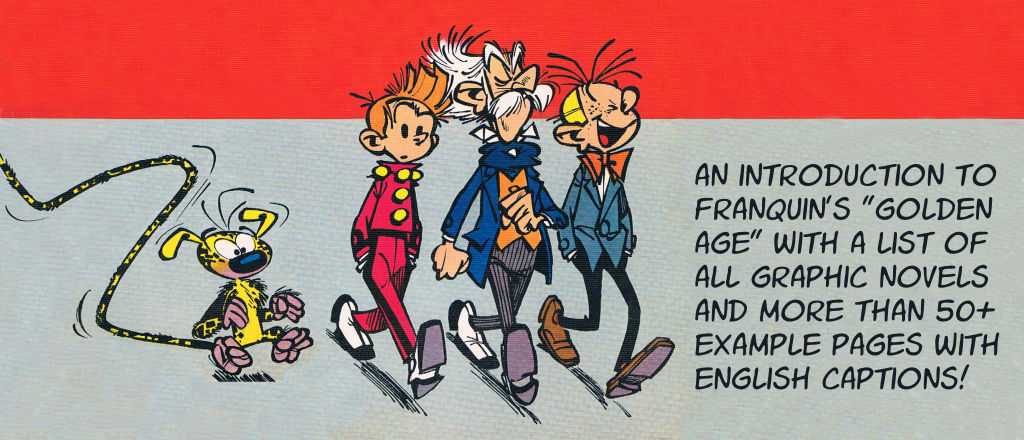
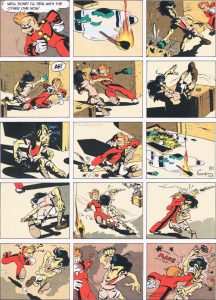
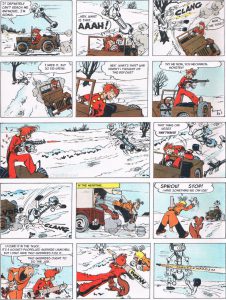
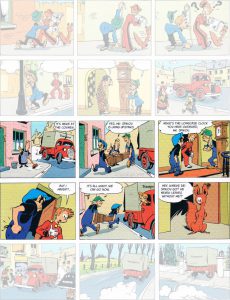
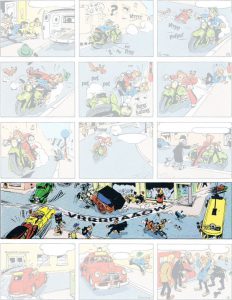
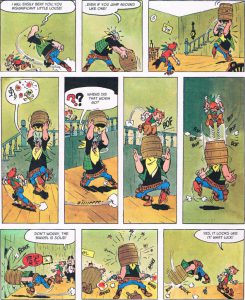
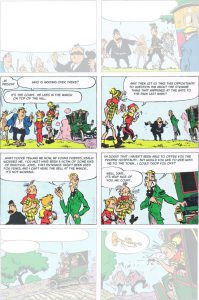
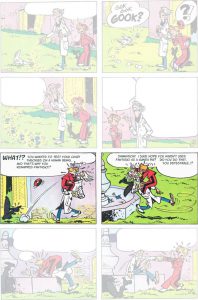
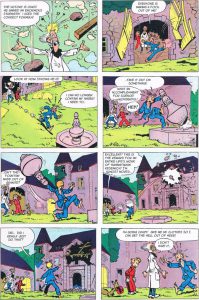
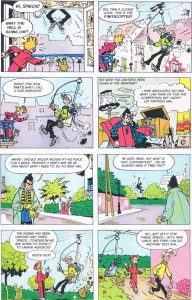
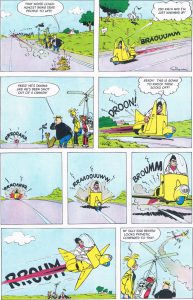
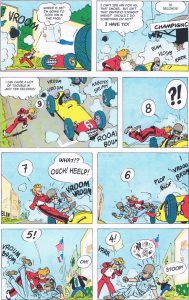
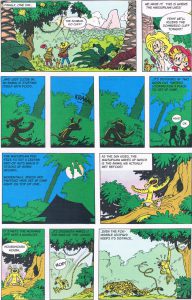
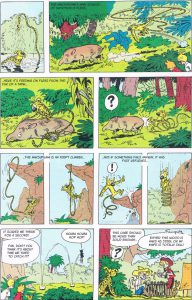
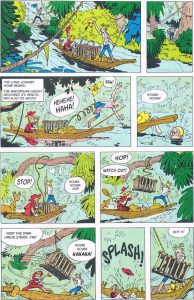
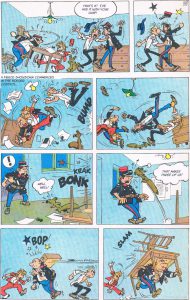
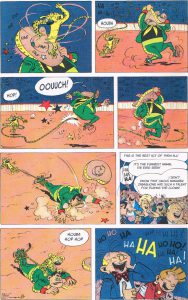
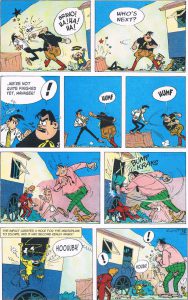

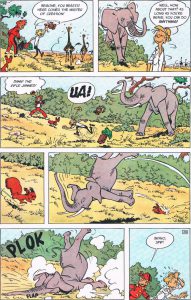
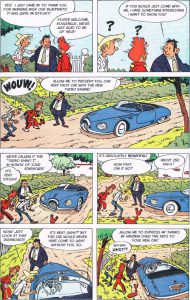

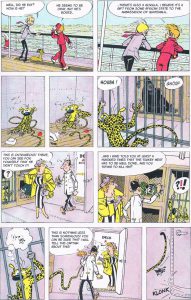

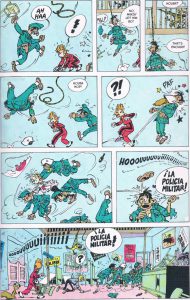
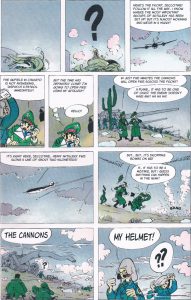
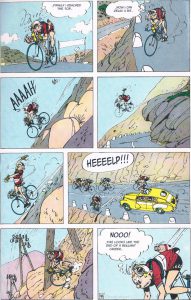
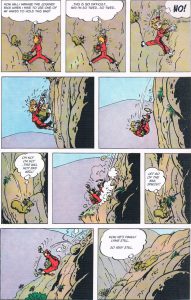

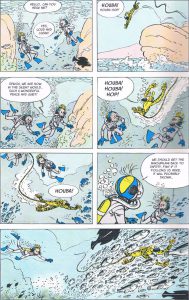
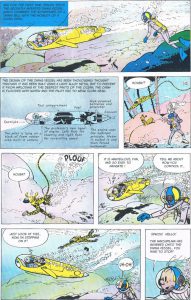
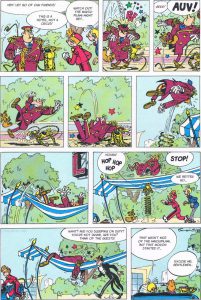
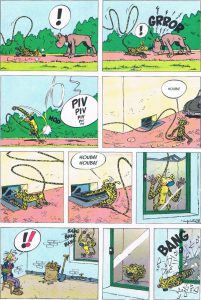
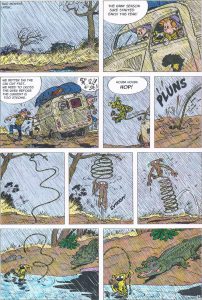
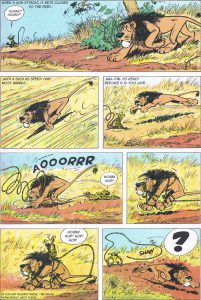
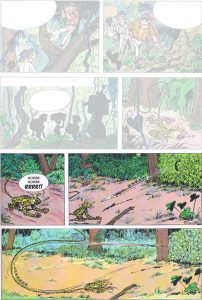


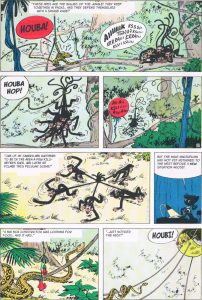
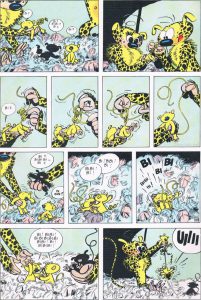
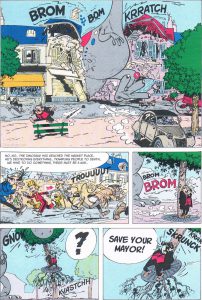
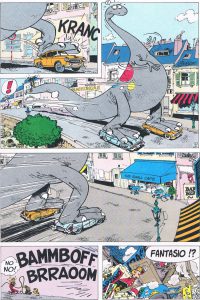
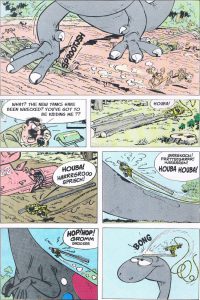
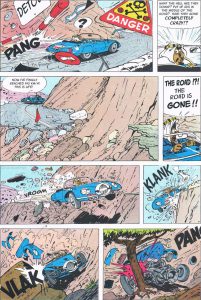
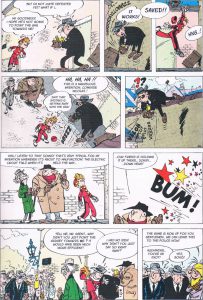
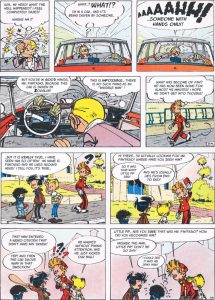

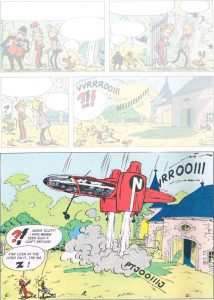
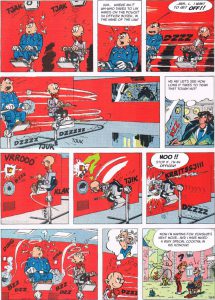

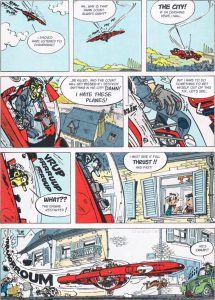
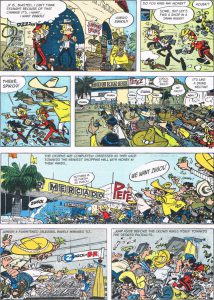


Good read; I remember reading some of these when sitting at the comic section in the library as a kid; remember them mostly because of the Marsupilami. Good idea adding an extra note to go to page two; would completely have missed the pagination 😀 . Some of the pages you’ve picked for page 2 feel very hand picked for what you’ve written while in other cases it feels like you’re talking of very specific events, but leaving out the pages where they’re shown).
I found out with the How a French Comic Series Inspired Star Wars blog post that I had to mention the other pages specifically. Some commenters on Facebook mentioned that the pagination could be hard to spot among the share buttons, and the pagination doesn’t even show up in RSS feeds.
Cinebook has translated 17/55 of the Spirou and Fantasio books, only 38 more books Cinebook has to translate to have all 55 books in English.